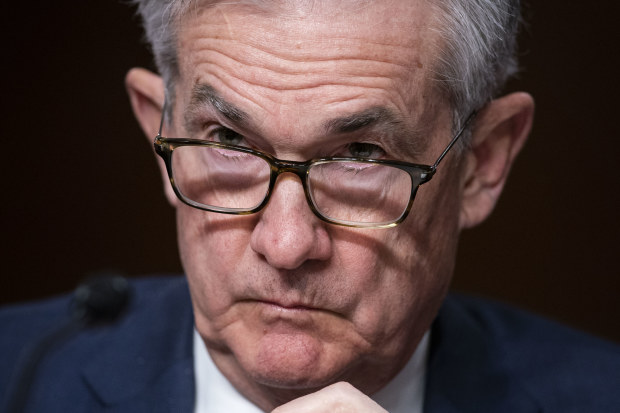Federal Reserve faces a policy dilemma of its own design
The Fed’s inflation-fighting credibility is damaged, and it has lost control of the monetary policy narrative.
Mohamed A. El-ErianThe Federal Reserve is in a deep hole of its own making as its top policy committee meets this week to announce the start of a long-anticipated cycle to raise interest rates.
Inflation is at a 40-year high and still accelerating, the Fed’s inflation-fighting credibility is damaged, and it has lost control of the monetary policy narrative.
Add to that the new host of uncertainties facing the global economy because of Russia’s invasion of Ukraine and it should come as no surprise that members of the Federal Open Market Committee have expressed divergent views in the run-up to their deliberations.
Fed chairman Jerome Powell. Bloomberg
Keeping the FOMC united is a tricky challenge for chairman Jerome Powell. Yet it pales in comparison to the importance of making the right decision among less-than-ideal policy options.
The Fed’s multiple headaches, as significant as they already are, do not stop there. I suspect that it will also face renewed criticism no matter what it decides this week. Understanding why is critical to illustrating the considerable uncertainty facing policy and the global economy, compounded by the tragedy in Ukraine.
A menu of choices that are less than optimal is often associated with policymaking, like the current Fed’s, that has fallen seriously behind developments on the ground, especially if citizens feel the pain directly, as many do today with soaring prices.
The central bank’s policy dilemma is particularly acute. Finding itself far away from the world of first best policy responses — for that, the Fed should, and could, have started easing its foot off the stimulus accelerator last summer, as some of us advocated — the options that the central bank has are far from straightforward and satisfactory.
Just consider the two main policy alternatives for the Fed.
‘Maximum employment’
With the “maximum employment” mandate met, according to Fed officials themselves — albeit with the level of labour force participation still too low — the central bank could go all in on inflation.
By taking bold actions upfront, it would minimise the risk of de-anchored expectations joining an existing set that is already driving up inflation (from higher commodity prices and rising wages to disrupted supply chains and costly transportation). This would involve starting the rate-hiking cycle with an increase of at least 50 basis points — signalling an aggressive set of increases to follow — and initiating the balance sheet runoff in the next couple of months.
This approach would allow the Fed to regain some of its inflation-fighting credibility and have better control of the policy narrative. I say only “some” because markets would still need to see follow-through, having witnessed the Fed grossly mischaracterize inflation as “transitory” until the end of November, continue to miss on its inflation estimates, repeatedly revise up forecasts (which it will still need to do again this week) and, as absurd as this sounds given how high inflation has been for many months, waiting until last week to halt completely its emergency liquidity injections.
The problem with this approach is that it risks sending the US economy into recession. This is not a risk to be ignored, especially given that the most vulnerable segments of the population would be most at risk. Having already experienced a significant erosion of purchasing power because of significantly higher prices on food and gas, they could now face both the fear and reality of further income losses.
‘Dovish tightening’
The other option is a “dovish tightening” cycle.
In this scenario, the Fed would raise rates by only 25 basis points on Wednesday (Thursday AEDT), leave rather vague its forward policy guidance and retain flexibility on how and when it will embark on reducing its bloated $US9 trillion balance sheet.
Again, this is not a highly attractive policy option. It would do too little to contain inflationary expectations, increasing the likelihood that workers and companies would seek to compensate more fully for past price increases and also start to take preemptive steps to protect against future inflation.
While it is particularly hard to predict confidently what the Fed will ultimately do, I am inclined to think that it may opt for some perceived middle ground that is tilted more heavily in favour of attempting a dovish tightening.
Specifically, a 25-basis-point increase would be accompanied by highly conditional language about what comes next as the central bank seeks to retain maximum policy flexibility both on rates and on the balance sheet.
This may appeal to some as “doing something on inflation” while constraining monetary policy’s immediate contractionary impulse and causing less indigestion for markets. But this would not be costless. It would come with a higher risk of both price and financial instability in the future — and, with that, risks to the real economy.
The one certainty in this is that, even after the FOMC meeting concludes on Wednesday, the Fed will continue to find itself in the deep hole it has dug for itself.
Mohamed A. El-Erian is president of Queens’ College, Cambridge; chief economic adviser at Allianz, the parent company of Pimco.

No comments:
Post a Comment